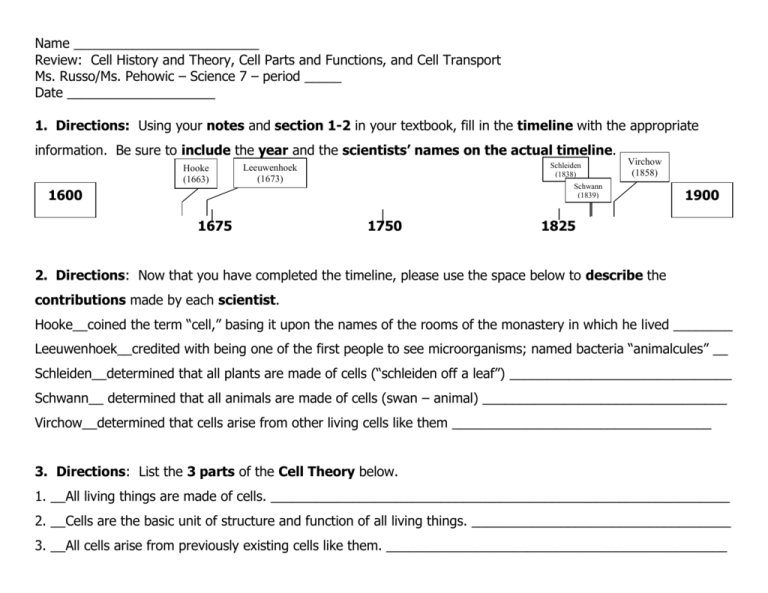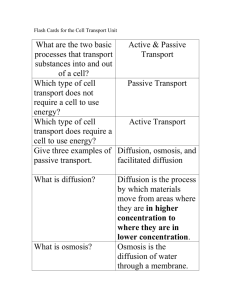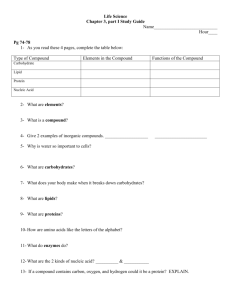Name - Madison Public Schools
advertisement

Name _________________________ Review: Cell History and Theory, Cell Parts and Functions, and Cell Transport Ms. Russo/Ms. Pehowic – Science 7 – period _____ Date ____________________ 1. Directions: Using your notes and section 1-2 in your textbook, fill in the timeline with the appropriate information. Be sure to include the year and the scientists’ names on the actual timeline. Hooke (1663) Schleiden (1838) Leeuwenhoek (1673) Schwann (1839) 1600 1675 Virchow (1858) 1750 1900 1825 2. Directions: Now that you have completed the timeline, please use the space below to describe the contributions made by each scientist. Hooke__coined the term “cell,” basing it upon the names of the rooms of the monastery in which he lived ________ Leeuwenhoek__credited with being one of the first people to see microorganisms; named bacteria “animalcules” __ Schleiden__determined that all plants are made of cells (“schleiden off a leaf”) ______________________________ Schwann__ determined that all animals are made of cells (swan – animal) _________________________________ Virchow__determined that cells arise from other living cells like them ___________________________________ 3. Directions: List the 3 parts of the Cell Theory below. 1. __All living things are made of cells. ______________________________________________________________ 2. __Cells are the basic unit of structure and function of all living things. ___________________________________ 3. __All cells arise from previously existing cells like them. ______________________________________________ 1-3 Enrich Worksheet Answers 1. a) Allows for building to take place. b) Transport materials throughout the town and sometimes outside of the town. c) Produces power for the town to run. d) Creates food for the town. e) Takes materials and changes them back to a form the town can reuse. f) Important decisions and functions of the town are controlled by the City Hall. g) Food and water supplies are stored in this location. h) Keeps unwanted things out. 2. a) b) c) d) e) f) g) h) Ribosomes are like protein building sites. The endoplasmic reticulum and Golgi bodies are like trucks moving materials throughout the cell. Mitochondria are like power plants providing energy for cell functions. Chloroplasts are the location of food creation through the process of photosynthesis. Lysosomes break down large molecules AND old organelles in order to release their components back to the cell for use. The nucleus is where all cell decisions are made. Vacuoles store extra food, water, and waste products. The cell wall/cell membrane let certain materials into/out of the cell. 3. Since the “Cell City” contains chloroplasts, this is an example of a plant cell. Section 2-2 worksheet Answers Directions: Fill in the chart below based upon the information given in each diagram. Material that is moving: Water Area of high concentration: Inside the fish cells Area of low concentration: The environment 1. Type of Transport: Passive - Osmosis Material that is moving: Oxygen Area of high concentration: The lung cells The cells of the Area of low concentration: bloodstream 2. Type of Transport: Passive – Diffusion Material that is moving: Sodium The nerve cell’s Area of high concentration: environment Area of low concentration: The nerve cell 3. Type of Transport: Active – Transport proteins Directions: Answer the Following questions using complete sentences. 4. Compare and contrast passive and active transport. Both forms of transport are the same because they are moving materials cells need. They are different because passive transport uses no energy to move materials from high concentration to low concentration. Active transport uses energy to go from low concentration to high concentration 5. Explain how osmosis differs from diffusion. Osmosis differs from diffusion because water molecules must move through a selectively permeable membrane. 6. Identify two methods of active transport. Transport Proteins – how your nerve cells work Transport by Engulfing – how amoebas and paramecia eat 7. Why is it important that cells are so small? If cells were big, the cell would not be able to fulfill all of its material requirements or life functions and would die. Directions: If the statement is true, write true. If it is false, write false and change the underlined word or words to make the statement true. __true ____ __________________________ 8. If a membrane is selectively permeable, it lets some but not all substances pass through. __false ___ ____Diffusion_______________ 9. Osmosis is the process by which molecules tend to move from an area of higher concentration to an area of lower concentration, with or without a membrane. __false___ ____Osmosis________________ 10. The process by which water moves through a selectively permeable membrane from an area of higher concentration to lowers concentration is diffusion. __false___ ____passive_________________ 11. Diffusion and osmosis are types of active transport. Note: See your teacher to have your created osmosis problems checked.





